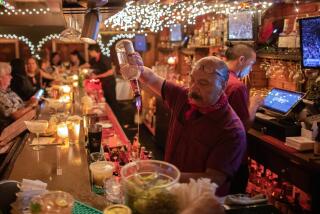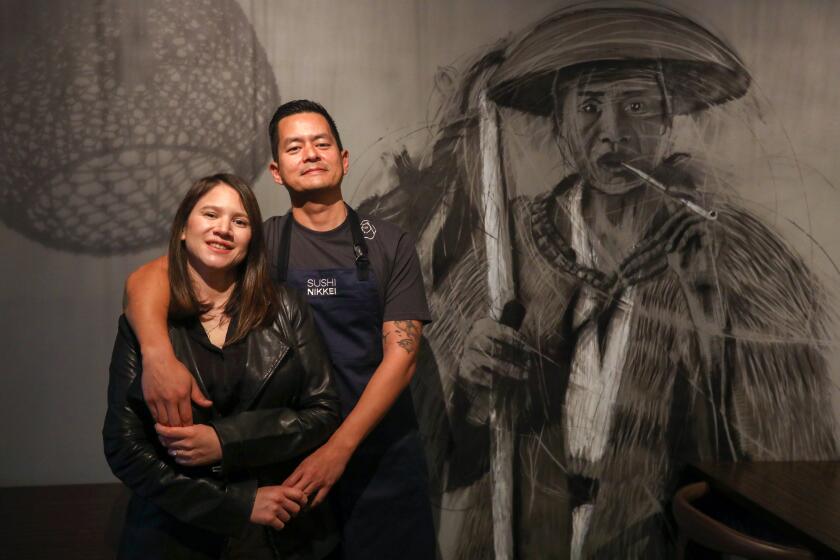A dining frenzy takes Gotham
New York City
It’s 6:30 on a Tuesday night, and the Spotted Pig in Greenwich Village is not a restaurant but a scrum. Every seat in the place is taken, the hostess is threatening a 90-minute wait for tables and the guy wedged next to me at the bar can barely lift his fork from his shepherd’s pie without hitting my eye with his elbow. It’s like eating on the A train but with better wine, not to mention more suits and cellphones per square inch.
It’s the kind of scene you would expect to find a five-minutes’ walk north, at the sprawling new Spice Market in the meatpacking district, where two of the most admired names in fusion food are turning away heat-seeking throngs. Or two minutes’ walk west, at the new Italian restaurant Barbuto, where California legend Jonathan Waxman is overseeing the underventilated kitchen. But the fact that the Spotted Pig frenzy is playing out in a self-described gastropub with no deeper credentials than backing from celebrity chef Mario Batali says everything about how the Manhattan restaurant scene has risen from near death by timidity and comfort food.
These days it’s almost as if Sept. 11 never happened and the ‘80s are back as unabashedly as Donald Trump’s hair-like appendage. The city is still struggling economically, but credit cards appear to be melting down on every corner as new restaurants open with ambition, energy and wine lists where Soave starts at $50 and bottles do not top off under four figures. Greed might not formally be good again, but no one’s saying it’s bad either. If you want to light up at Davidburke & Donatella, there’s actually a smoking section in the white stretch limousine waiting right outside.
After a bleak couple of months when all the news seemed to be closings of musty legends -- Lutece, La Cote Basque, Gage & Tollner -- suddenly the focus is on the shiny new, and not just at the fancy food court in the mall, as snarkier Manhattanites dismiss the Time Warner Center at Columbus Circle. As soon as restaurants open anywhere in Manhattan, they’re packed with diners eating and especially drinking as if there’s no tomorrow (a mood that swings with every development in the Sept. 11 hearings and the Iraq war).
Chefs on the move
Some of the best young name chefs are reinventing themselves, as Laurent Tourondel has done in casting off his reputation as the seafood wizard of the wildly praised but short-lived Cello and opening heavy-on-the-red-meat BLT Steak in midtown. He still serves fish, including an outstanding tuna tartare, but he makes his money off the $72 porterhouse for two, with all side dishes extra (gnocchi as good as any in Italy, superlative braised collard greens, heart-stopping potato gratin).
Some of the best older name chefs are finding new perches, as Christian Delouvrier has done since his two new ventures failed to materialize after the closing of the four-star Lespinasse, where he charged $36 for a bowl of soup. He recently decided to join Alain Ducasse at Alain Ducasse at the Essex House in midtown.
And many chefs whose names are not exactly household words even in New York City are packing their dining rooms by focusing on mid-level, mid-priced dishes that are just creative enough, as Marc Murphy is doing at the new Landmarc in Tribeca. His oversized menu offers up dishes from warm goat cheese profiteroles to boudin noir, with steaks, mussels and salade nicoise in between.
As fast as these restaurants open, they have to run to keep up with new competition. Gray Kunz, a groundbreaking chef who held four stars at Lespinasse before Delouvrier took over there, is set to open Cafe Gray in the TWC any day, maybe even by the time Thomas Keller gets the fire damage repaired at his ill-fated Per Se. Steve Hanson of the huge BR Guest group is opening his first venture in the meatpacking district this week, with the chef from the highly rated Fiamma overseeing the kitchen at Vento. And Tourondel has said he intends to open a seafood restaurant in the Flatiron neighborhood later this year.
It all represents a sea change on this small island. For the longest time after the darkest days of late 2001, heavily residential neighborhoods were where Manhattan restaurateurs went shopping for space. New Yorkers were clinging close to home, and chefs including Charlie Palmer (of Aureole fame) and Tom Valenti (of the popular Alison on Dominick) catered to them, opening nonthreatening places on the tame Upper West Side, for instance. But now the tectonic plates seem to be shifting under the city, and the map is being redrawn. Diners here, after all, can get just about anywhere by subway, for the same $2, whether they’re heading for Times Square or Harlem.
And so the grubby meatpacking district, just on the northwestern edge of Greenwich Village, is now the prime destination for chefs looking to feel literally on the cutting edge, partly because boutique hotels like Gansevoort House and snooty clubs like Soho House are opening on the brick streets just east of the Hudson River. The Lower East Side, where so many streets still look straight out of “Crossing Delancey” with Spanish subtitles, is just as much a hot property now, with its own hotel, superb movie theater, cheap rents and singular atmospherics.
Even the bleak streetscape of far-west Chelsea has attracted restaurateurs who believe that if you design it, they will come. Right across from the housing projects is the Biltmore Room, with famously creative Gary Robins plying the crossover cuisine he perfected at restaurants here and in Miami, and it’s doing so well I have yet to snare a reservation. (It’s my fault: I just don’t want to eat at either 5:30 or 11.) Not only is it drawing from all the art galleries displaced from SoHo to Chelsea but it also pulls from a huge pool of free spenders working at the Starrett-Lehigh building, not so long ago a factory/warehouse but now home to upscale companies including Clicquot wines, Assouline publishers and the ultimate style setter, Martha Stewart Omnimedia.
Cosmopolitan tastes
Huge waves of tourists, especially of the flush euro- and yen-spending variety, are also changing where and how New York eats. Several of the newest hip restaurants are in hotels willing to invest in that most crucial amenity: a name chef. Incongruous as it sounds, Marcus Samuelsson of the nouveau-Scandinavian Aquavit is now serving sushi (foie gras with tuna, for starters) and green tea doughnuts at Riingo, in the Alex in midtown. A few refugees from Lespinasse have transformed the restaurant at the Time Hotel off Times Square into Oceo, where the Champagne-roasted striped bass arrives under artichoke mousseline and over a ragout of horseradish and cubed brioche (and where appetizers run $19).
Asiate, on the 35th floor of the Mandarin Oriental in the Time Warner Center, is the ultimate hotel restaurant, one that feels like Chicago or Hong Kong although it looks right down on Central Park. The vertiginous view almost detracts from Noriyuki Sugie’s creations, such as grilled Muscovy duck breast twisted into a hot dog-like cylinder and served with white beans and duck prosciutto, which are not quite as wild as those at his last job, at Tetsuya in Sydney. At lunchtime recently, Tim Zagat of guide notoriety was one of the few diners who was not taking souvenir photos with either a digital camera or a cellphone.
(The tourist impact is felt even at grubby street level: A friend whose companion runs a SoHo bar unchanged from the ‘70s swears not one patron on a recent Saturday spoke English he could eavesdrop on.)
Vicarious globe-trotting
For stay-at-home New Yorkers, too fear-ridden to get on a plane anymore, many of the new restaurants could pass for vicarious travel. Spice Market is so over-designed to look like somewhere else, complete with straw suitcases wedged near the rafters in the subterranean lounge, that it would feel at home in the Mall of America. La Bottega, in the Maritime Hotel, struggles mightily to evoke a seaside bar in Italy (big cans of tomatoes stacked to the ceiling don’t quite do it, though). And the Spotted Pig tries so hard to be English that it speaks with a Madonna accent.
New Yorkers have always been suckers for faux, with bistros like Balthazar knocking off Paris, but never more than today. Maybe it’s the Broadway influence: All the city’s a stage. Or maybe it’s just that the city has taken such a hard lesson in how ephemeral reality can be. Spice Market, opened by Jean-Georges Vongerichten with Gray Kunz consulting, has gotten mixed reviews for its interpretations of Asian street food, including mushroom egg rolls with galangal sauce, steamed lobster with chilies and durian ice cream. But surprisingly sophisticated people all seem to be taken in by the design. It looks like Asia, all right, but only if you’re thinking of a theme restaurant like Indochine 1929 in the yuppie area of Hong Kong.
The first three restaurants to break out of the post-Sept. 11 bleakness apparently set the tone by putting as much, or more, emphasis on design as food. The Biltmore’s decor relies on walls and wood and marble salvaged from the famed hotel of the same name; it could be a Rockefeller room in the Metropolitan Museum. Lever House, in the groundbreaking ‘60s skyscraper on Park Avenue, looks like a very sleek first-class lounge in the old Pan Am Terminal at JFK Airport. (The heavy-on-the-crust fruit crisp completes the aura.) And Schiller’s Liquor Bar on the Lower East Side, cousin of Balthazar, is a designed-to-the-last-crazed-tile restaurant posing as a restoration of a neighborhood landmark. (One clue not to believe your eyes: The Heimlich “poster” is screened onto the busboys’ T-shirted backs.)
But at the best of the new places the scene fades once the first plate lands. Davidburke & Donatella is in a townhouse on the Upper East Side that blends elements of Versace and Brooke Astor, with an old-style chandelier and voguish white leather chairs. But the cooking has its own singular style, courtesy of Burke, one of the most fearless chefs in New York, who made his name at the River Cafe in Brooklyn and was clearly itching to return to those wild and crazy days when he could send petits fours out still baking on a hot little cast-iron stove.
A meal there might start with shot glasses of foie gras mixed with steak tartare and progress through lobster-Sauternes flan served in a brown eggshell with a quail breast and a beggar’s purse of the leg on the side. For main courses, Burke riffs on his old innovations like the swordfish “chop” he patented: Now he’s serving a slab of veal the size of a haunch that he calls filet mignon because it’s cut from the most tender part of the calf, and he’s sending out lobster “steak,” with the chunks of the meat formed into a huge patty.
The signature dessert is a “tree” with cheesecake lollipops perched at the end of each branch.
A meal like this would have been unimaginable only six months ago, when so many chefs were reluctant to risk being mildly creative, let alone wildly whimsical. Now even a place like the Spotted Pig can do more than grill up burgers and ladle out smoked haddock chowder. It can offer sauteed veal kidney with turnips and still attract longer lines than a new Krispy Kreme outlet. The fear factor may not be completely gone in this city, but it’s faded for now.
*
Hot list
These are some of New York’s noteworthy new restaurants, for the food or for the scene.
Spotted Pig, 314 W. 11th St., (212) 620-0393.
Spice Market, 403 W. 13th St., (212) 675-2322.
BLT Steak (Bistro Laurent Tourondel), 106 E. 57th St., (212) 752-7470.
Oceo, 224 W. 49th St., (212) 262-6236.
Landmarc, 179 W. Broadway, (212) 343-3883.
Asiate, Mandarin Oriental, 80 Columbus Circle, (212) 805-8881.
Schiller’s Liquor Bar, 131 Rivington St., (212) 260-4555.
Davidburke & Donatella, 133 E. 61st St., (212) 813-2121.
More to Read
Eat your way across L.A.
Get our weekly Tasting Notes newsletter for reviews, news and more.
You may occasionally receive promotional content from the Los Angeles Times.






